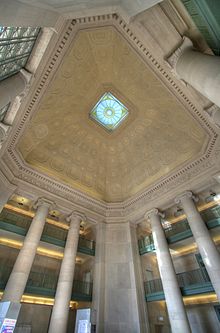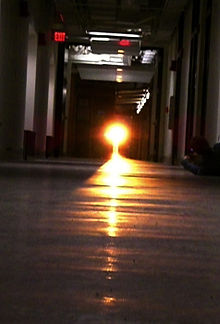- Infinite Corridor
-
The Infinite Corridor[1] is the hallway, 251 metres (825 feet, 0.16 miles) long,[2] that runs through the main buildings of the Massachusetts Institute of Technology, specifically parts of the buildings numbered 7, 3, 10, 4, and 8 (from west to east).[3] The corridor is important not only because it links those buildings, but also because it serves as the most direct indoor route between the east and west ends of the campus. The corridor was designed as the central spine of the original set of MIT buildings designed by William W. Bosworth in 1913.[4]
"Traffic" in the corridor can be quite heavy at times, and in fact one legendary "hack" (practical joke) in 1985 involved placing traffic signals, lane markings, and highway-like signs along its length.[5] On occasion, students in the Transport Lab of the Department of Civil and Environmental Engineering (CEE) have studied foot traffic in the Infinite Corridor, as a safer, more accessible model of highway traffic. One student report made the following observations about the informal rules that seem to apply to Infinite Corridor traffic:[6]
"The rules of the road for the Infinite Corridor include: stay to the right, limit group size, pass on the left, form a line at bottlenecks, don't stop/slow down, no tailgating, traffic within corridor has right of way, no physical contact and no eye contact.
Twice per year, in mid-November and in late January, the corridor lines up with the plane of the ecliptic, causing sunlight to fill the entire corridor, events that are celebrated by students and staff.[7]
Contents
Location
An outside grand stairway leads up from Massachusetts Avenue to Lobby 7, the main entrance to the Infinite Corridor. This location is often called "77 MassAve", an abbreviation of its official street address; the street itself forms the western boundary of the main or central campus. The MIT Student Center (Building W20) is located directly across the street, at 84 Massachusetts Avenue.
Nearby bus stops serve MBTA buses from Harvard Square, and from Back Bay across the Charles River via the Harvard Bridge, as well as various shuttle buses. Food vendor trucks often park in designated spaces near the entrance.
Lobby 7
Lobby 7, so named because of its location in Building 7 (formally named the Rogers Building), is a large 100-foot vertical space open all the way up to the interior of the Little Dome (rarely called the Small Dome). A carved inscription[8] circles the space just below the base of the Little Dome, and has been the subject of a masterfully-crafted hack.[9] Four empty pedestals occupy the corners of the square lobby; they were originally intended for large figural sculptures, but are instead often occupied by students studying, or occasionally playing music. The Infinite Corridor begins straight ahead through the lobby, on the opposite side from the street.
Lobby 7 is frequently used for formally-scheduled or impromptu concerts. During the 1970s, two large pillars flanking the entrance to the Infinite Corridor were partially wrapped in paper and used by the liberal "Alternative Advertising" and somewhat less liberal "Pillar Productions" where students would scrawl responses to issues of the day such as nuclear power or whether disco sucked. A display of Air Force art was once withdrawn after vandalism in the lobby.[citation needed]
Banners are often hung from the upper levels of Lobby 7, including the occasional hack such as "Don't let the Grinch steal your Christmas" in reference to the common complaints about the campus Christmas tree. The cavernous interior space of Lobby 7 is frequently the site of large-scale indoors hacks.[10]
Decorations
The walls lining the Infinite Corridor were painted stark "Institute Gray" with black doorway trim until Spring 1970, when a number of wall murals appeared. With two notable exceptions, the paintings were soon replaced by bulletin boards and enclosed display cases which remained largely unchanged for several decades. A Summer 2010 renovation installed more-durable boards, and more clearly marked many portions of them as reserved for exclusive use by one specified student activity or another.
The Cashier's Office wall was painted as a giant dollar bill for over 25 years (and was the subject of a number of hacks),[11] but this was eventually removed and replaced with a glass wall when that space was converted to a community lounge.[12] A picture of the old wall mural is etched into the glass, as a historical marker. The oldest remaining wall mural (near the Admissions Office) is an early-1970s style colorful painting of a "multicultural" group of people walking quickly. Having survived many renovations and repaintings of the Infinite Corridor, the mural now is a carefully-preserved relic of that era.
Some adjacent laboratories, notably those of the Department of Materials Science and Engineering (Course 3), now have floor-to-ceiling glass walls and large posters or display cases explaining some of their research activities.
Lobby 10
A two-story atrium space at the half-way point of the corridor, known as Lobby 10 (part of the MacLaurin Buildings in Building 10, underneath the Great Dome), features walls on which are engraved the names of MIT alumni who died in each of several wars. In Lobby 10, it is quite common to find several booths or tables advertising upcoming events, or students engaged in other public activities and demonstrations, such as juggling or dancing. Often, there are fund-raising activities, such as selling used books, tickets for shows, items made in the MIT GlassLab, or Chinese pastries.
Different levels
The Infinite Corridor has five levels. The first floor (called the "ground floor" by some) is the most traveled level, and is often the only one referred to as the Infinite Corridor. It is half a floor above ground level at Massachusetts Avenue (the west end), and in areas is a full floor up, with a parking lot entrance passing underneath (this entrance crosses the basement-level corridor at grade). At its east end it is also about half a floor up, with nearby stairs going up to the second floor and down to the first floor of adjacent, newer buildings, which were built with lower ceilings. The Infinite Basement Corridor mirrors the first floor passage, but connects to the extensive below-grade system of tunnels connecting many buildings.
MIThenge
On several days each year, the sun sets in alignment with the Infinite Corridor and shines along its entire length. This is known as "MIThenge", a reference to Stonehenge's alignment with the sun (although the type of alignment bears a closer relationship with that of Newgrange and Maeshowe in that the sunlight passes through the mass of the buildings rather than through the standing stones of Stonehenge). These alignments occur on several days around January 31 and November 11. The phenomenon was spotted, calculated, and popularized in 1975-76 according to a Sky and Telescope article. The MIThenge site has more information and predictions for when the phenomenon will occur.
Demonstrations
During the 1960s, a common Technology Day demonstration used the unobstructed length of the corridor to demonstrate the speed of light in a simple, direct way. A strobe light, photocell, and oscilloscope were positioned at one end of the corridor, and a mirror at the other. The round-trip time was about two microseconds. The photocell picked up both the direct and reflected flashes. The flash duration being well under a microsecond, the result was two nicely separated pulses on the oscilloscope screen.
References
- ^ Hapgood, Fred (1993). Up the infinite corridor: MIT and the technological imagination. Reading, Mass.: Addison-Wesley. ISBN 0-201-08293-4. 203 pp.
- ^ MIT Infinite Corridor Astronomy - MIThenge, Northeastern University Press, 2004.
- ^ Nancy Eleanor Joyce and Frank O. Gehry (2004). Building Stata: the design and construction of Frank O. Gehry's Stata Center at MIT. MIT Press. pp. 11–12. ISBN 9780262600613.
- ^ Mark Jarzombek, Designing MIT: Bosworth's New Tech, Northeastern University Press, 2004.
- ^ Peterson, Institute Historian T. F. (2011). Nightwork: a history of hacks and pranks at MIT (updated edition). Cambridge, Mass.: MIT Press. pp. 47–49. ISBN 978-0-262-51584-9.
- ^ Wright, Sarah H. (August 27, 1997). "Students study MIT's central artery". MIT Tech Talk. MIT News Office. http://web.mit.edu/newsoffice/1997/artery-0827.html. Retrieved 2011-06-01.
- ^ Bill Coyle (1998). "Massachusetts Institute of Technology". In Carol J. Summerfield, Mary Elizabeth Devine, and Anthony Levi. International dictionary of university histories. Taylor & Francis. pp. 262. ISBN 9781884964237.
- ^ ESTABLISHED FOR ADVANCEMENT AND DEVELOPMENT OF SCIENCE ITS APPLICATION TO INDVSTRY THE ARTS AGRICVLTURE AND COMMERCE CHARTER MDCCCLXI [carved in all capitals without punctuation]
- ^ "Changed Lobby 7 Inscription". MIT IHTFP Hack Gallery. http://hacks.mit.edu/by_year/1994/entertainment_and_hacking/entertainment_and_hacking.html. Retrieved 2011-05-02.
- ^ "Hacks In Lobby 7 and the Infinite Corridor". MIT IHTFP Hack Gallery. http://hacks.mit.edu/Hacks/by_location/inf_corridor.html. Retrieved 2011-05-02.
- ^ "$10,000 Bill Mural at the Cashier's Office". MIT IHTFP Hack Gallery. http://hacks.mit.edu/by_year/1993/10K_bill/. Retrieved 2011-05-02.
- ^ "Teardrop on dollar bill mural". MIT IHTFP Hack Gallery. http://hacks.mit.edu/Hacks/by_year/2005/goodbye_dollar_bill/. Retrieved 2011-05-02.
External links
- MIThenge and photo
- Alan Eliasen has lots of information about MITHenge solar and lunar events and predictions for future dates.
- How MIThenge Got Its Start, Slice of MIT blog 2011
Categories:- American architecture
- Massachusetts Institute of Technology
Wikimedia Foundation. 2010.



